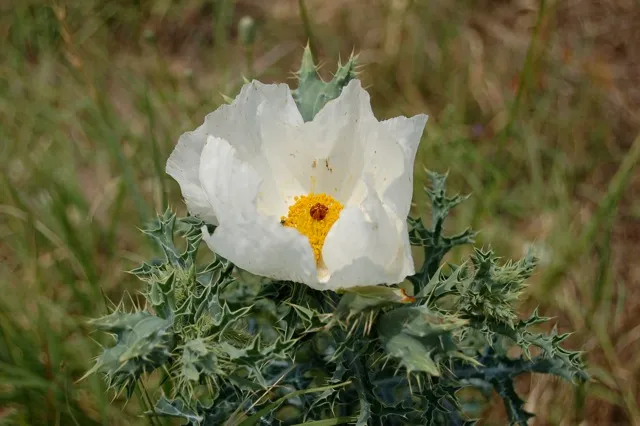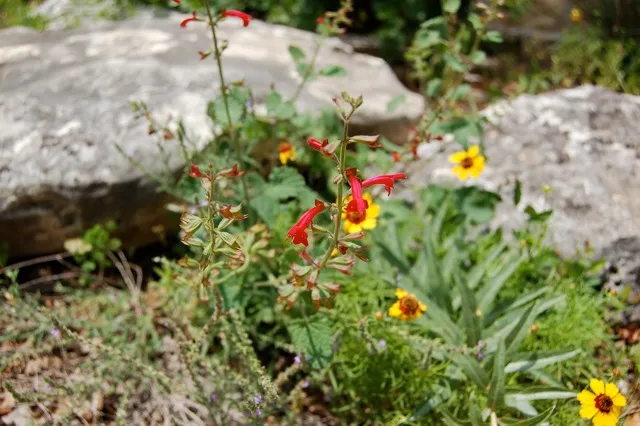By Delmar Cain
May is preservation month in Boerne. There will be no better time to ponder the unique and beautiful place in which we live and the challenges in preserving it. Admittedly most of the events of the month will focus on historical buildings, local family and commercial history and important historical events. But I am sure that the Boerne Area Historical Preservation Society would not begrudge my attempt to focus a bit of attention on the natural beauty of the Hill Country that along with the fertility of the soil attracted the settlers who began arriving in the nineteenth century. It is worth remembering that some of our oak trees were mature when Stephen F. Austin took over his father’s land grant in 1821.
A few weeks ago Wilt Shaw and I had the opportunity to walk along the west side of Cibolo Creek opposite the Cibolo Nature Center along the boundary of the Herff Farm. Even though our area (until last week) had received only a thimbleful of rain for the past eight months the wildflowers and native trees were doing their best to provide blossoms and fruit. We saw a cedar sage (Salvia Roemeriana) touting its small red blooms, white prickly poppies (Argemone albiflora) delicately waving in the breeze, and the big red sage (Salvia pentstemonoides), planted and fenced in 2004 – 2005 by Bill Ward and Ralph Lay, putting up new stalks and looking healthy for its show time in late summer to early fall.

The white prickly poppies were scattered in the fields that had once been planted with crops. Before being farmed the fields had been cleared of their native plant and tree inhabitants. The plowed rows, although not plainly visible because of the grasses, reveal themselves through the shock absorbers on your vehicle. For our more mature citizens mdash; think rub board. Usually found in waste places and open grassy fields and often on a noxious plant list, the white prickly poppies returned uninvited when the farming stopped.
The cedar sage was located along the fence in the shade of a large hackberry tree that stood where the field sloped down to the creek. Probably the cedar sage was in an area that had never been cleared. It and its antecedents could have occupied that location when bison still rambled across the plains and long before Ferdinand Herff first purchased the land in 1852.
The big red sage on the sloping banks of Cibolo Creek is there because of Bill Ward, who was intrigued by the story of a plant considered lost and then rediscovered. It may have been widespread at one time, but now exists in the wild in only a few discrete and naturally protected areas. Bill wanted to help it make a comeback because for whatever reason — deer, livestock, farming or adaptability—its existence in the wild is precarious and it will need care and protection to survive.
Three plants located within 100 yards of each other and yet three different stories about preservation. The white prickly poppy takes care of itself—no preservation necessary. Farmers didn’t want it in their cultivated fields but probably didn’t consider it enough of a nuisance to chase it into the areas which could not be cultivated. And if your neighbor didn’t farm, you would have had a tough sell motivating him to eradicate his white prickly poppies. Sure it’s prickly, but it has a nice flower—almost sounds like a rose. So when farming stopped on the Herff Farm, the progeny of the white prickly poppy, along with a probably better known but unrelated rough character, the bull nettle (Cnidoscolus texenus), opportunistically took up residency in the abandoned field.

Most of the time the cedar sage grows in the shade and often along the edge of a canyon. Its place along the fence line and under the old hackberry meant that it might never have been disturbed by human activity. Because of its proximity to the fence this plant might have received some protection from the white-tailed deer and the axis deer (which apparently having displaced the antelope on the playground, indicates a possible preservation failure). The cedar sage, a perennial, was situated right where it was expected to be. And like most of our native plants, as long as its habitat is not changed, the cedar sage will continue to show up year after year. But here is the caveat. If there is anything that we residents like to do, in addition to watching high school football, it’s cranking up our riding mower and changing habitat.
The third plant, the big red sage, which exists in the wild in very limited numbers, has a history of being lost and found, dating from the collection of its first specimen by Ferdinand Lindheimer in 1845. (For the full story and a picture of big red sage read Bill Ward’s two articles—Big Red Sage Near Boerne, Then and Now—October 2009 and More Big Red Sage Found in the Texas Hill Country—December 2010 under “Publications” on the Boerne NPSOT website: http://www.npsot.org/wp/boerne/). When he planted rosettes along the Cibolo Creek, Bill Ward was attempting to reestablish the big red sage in a habitat resembling that in which it had originally grown. The fact that it is found in such small numbers in the wild means either that it was never widely distributed or it has had difficulty with habitat changes. In either event vigilant human care will be necessary for it to succeed. The plant’s propagation from the seeds of a wild population in 1987 allowing plants to now be raised at botanical centers and in private gardens probably means that it will not go extinct. But preservation in the wild is far from certain.
So from my vantage point, the moral of this story is that preservation of the natural beauty of our area like the preservation of “family values, historic buildings, objects and places” must be considered on an individual basis. It depends on what we are trying to preserve—just as with the plants. Some things will do just fine regardless of what we do, most things will do just fine as long as we keep “the mower and the herbicide in the garage” and some things are going to need all the help we can muster.


